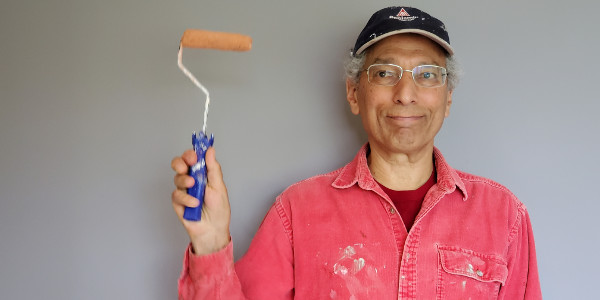Perfectly good enemy
I’ve been painting. Most recently, the two toilet rooms in our house. I resist calling them “bathrooms,” since neither has a bathtub. Calling such a room a “half bath,” is even worse (which half of the tub are we talking about?); “powder room” is about a hundred years out of date, and “restroom” is a silly euphemism. “Loo” is perfect, but only in the UK. So I’m stuck with “toilet room.” Even though it’s awkward, and used by almost no one else.
As usual, the prep took much more time than the actual painting—toilet rooms are the worst. I won’t remind the reader who also does painting, nor attempt to explain to the non-painter, the need to remove the fixtures from the walls and ceiling, clean the surfaces to be painted, put down floor and counter protection, and tediously cover the toilet, the other plumbing, and the non-removable fixtures. And tape around the trim.
Finally, after what ended up being several days of intermittent prepping, I was ready to put brush to paint. The ceilings came first, of course, so that any drips down the walls could be subsequently painted over. But doing the walls comes with the lurking danger of painting a bit too high, so that the pristine ceiling gets marred. (My ever-present wall painting question is whether to use the Shur-Line edge painter, a little flat pad on a frame with rollers to [theoretically] produce a clean line at the top of the walls, or tape the perimeter of the ceiling and use a brush. I ended up doing some of each because, in my hands, neither worked particularly well.) Last comes the tedious trim. In the lower toilet room, not only were there the usual baseboards and door trim to deal with, but the treacherous crown molding at the junction of the walls and ceiling. To paint it, tape had to be applied to both the ceiling above and the walls below, exposing the narrow strip of molding. Thinking about all that taping forced another big decision: should I use the usual blue tape, or the more expensive but supposedly superior Frog Tape (which, predictably, was green)? In the spirit of a controlled clinical trial, I used some of each. Alas, after de-taping I forgot to compare the results. So don’t ask me whether Frog Tape is worth the extra bucks.
While doing all this painting I realized, not for the first time, how incredibly present one must be. A painter has to be aware of everything going on around them: Paint dribbled off a brush may land on the floor, with a proclivity for the tiny unprotected spot where the painter’s cloth has been inadvertently pushed out of place. No matter how tenderly it’s held, the paint tray, which holds a pool of paint for the roller to soak up, can tilt and spill. Alas, both occurred during the toilet room paintings. Moreover, while squatting to paint the baseboard, I backed up to get a better angle and knocked over the paint pot with my heel. (Announcement: spilled paint penetrates even thick, 10 oz painter’s cloth and has to be scrubbed up from the underlying wood floor.) Then, while stretching on the ladder to paint the crown molding, my left elbow grazed the freshly painted wall, leaving complimentary ovoid tattoos on both the wall and my elbow. Shortly after that incident, while standing on the top step of the ladder, I was very mindful of my elbows. But not my head, which bumped against the ceiling. Fortunately, my painter’s hat provided a bit of insulation, so neither head nor ceiling was damaged.
How different painting is from quotidian life, when we’re on autopilot most of the time! Rather than being constantly aware of all of our body parts and how they’re arranged in space, we progress through the day accomplishing various activities while barely conscious of what we’re doing. My morning ritual—preparing a pot of tea and cutting two slices of bread to make toast, is done almost completely on autopilot. Occasionally, when I’m a touch distracted, I realize I have no idea how many spoonsful of tea I’ve put in the teapot.
Perhaps, as while we’re painting, we should always try to be actively aware of what’s going on all around us. I guess that must be what Navy Seals are taught to do, at least while they’re on the job. But it seems unlikely that even Seals could live their entire lives in a state of high alertness; such a level of attention and concentration would be exhausting. So maybe it’s a good thing that we can usually get through the day without constant vigilance.
Though tedious and fraught, the one lovely thing about painting is that there are lots of second—and even third and fourth–chances. In other words, unlike most of the rest of life, the consequences of lapses of attention are generally easily corrected.
Here’s how it went for me: After doing the main three paintings—ceiling, walls, and trim, it was time for touching up. Despite the use of the Shur-Line edge painter and the blue and green tape, the ceiling brandished numerous spots of errant wall paint. I touched up part of the ceiling freehand, with a small brush. It went well, but I didn’t always get a nice, sharp line between the ceiling and the wall. In other places, to try to maintain the sharp line, I decided to use Frog Tape on the upper wall as I re-whitened the ceiling. That strategy seemed sound. But when I pulled the tape off the wall, occasional patches of paint came off too. So both methods of ceiling repair resulted in my having to touch up the wall. And when I did, I sometimes once again hit the ceiling with my brush, meaning I had to retouch the ceiling for a second time. And then the wall again. At least with each successive touching up sequence the total area requiring attention became progressively smaller. But it was asymptotic–the need for touch up never diminished to zero. Since some sections of the wall-ceiling interface looked gorgeously sharp, it was hard to let those that didn’t lie fallow. So in some places, I’m embarrassed to admit, I did as many as four or five cycles of alternately retouching those two right-angled planes.
Finally, after I’d lost count of all the retouching cycles I laid down my brushes and Frog Tape. But I hesitated for days to reinstall the towel racks and toilet paper holders and light fixtures. Because that would have been an acknowledgement that the painting, with its imperfect results, was truly done. If I held off putting the room back together, I could tell myself that after a little break I’d do yet another round of touching up, approaching ever closer to that elusive state of perfection.
But one day the absurdity of such striving struck me. After obsessing over a tiny spot I’d missed in a hardly-noticeable area of the wall behind the bathroom sink in the upstairs toilet room, I turned around to leave. There was a big yellow plop of paint just above eye level on the natural wood door. Yellow was the original color of the wall that I’d just painted over. I was shocked–the same eagle eyes that were detecting tiny flaws in the new paint job had for days glossed over a major painting mistake that was directly in front of me whenever I left the toilet room. It had been there since we bought the house, two decades ago. Perhaps I’d been able to ignore it for all those years because I wasn’t responsible for it. And strangely, even after noticing it, it really didn’t bother me. I had no urge to fix it. Hmm.
It’s said that “the perfect is the enemy of the good.” Certainly that’s true. But after painting and obsessively touching up the two toilet rooms, I’m beginning to think that maybe even “good” can be a bar too high. In many cases, maybe “adequate,” “acceptable,” or “good enough” is what we should aspire to. Maybe the better phrase is “the good is the enemy of the it’ll do.” I hope I can remember that the next time I pick up a paint brush.




Well, if you missed that yellow blob on the door all these years, it should be only moments before you stop seeing the tiny flaws in the recent paint job! I wonder if Annie has even noticed them? I hope you resisted pointing them out!
Good one, Ken! We’ve spent WEEKS paining our entire house and we feel your pain. I promise that I will leave my reading glasses in my purse when I visit next time… 👓
Ken, I am so impressed that you got those toilet rooms painted, and perhaps with all that work should be renamed Toiling Rooms. It is interesting that the word painted begins with “pain,” which I felt as I was reading about your
pain-staking (!) brush passes, and more passes, and yet more passes.
Your photo is grand! The roller looks like a sign of surrender, and you are still smiling! And such a nice shirt that you sacrificed for your venture.
Your detailed description of the painting is perfect timing, as most of our interior needs to be redone. I will remind Terry that he should probably get bids from the Pro’s, ere he becomes the Painter turned Fainter.
Send pictures of your handiwork!
As co-owner of said toilet rooms, I’ll simply say that the painting (walls, ceilings, trim) in both look great .And, I’m glad they’re finished!
Ken,
You’re a brave man to have undertaken this paint job. All those details…and all that prep work!
Your comment about the yellow spot on the door is fascinating. How and why do we accept the familiar “spot” and deplore the new one?
Anyhow, after reading this essay, I’ve decided to hire a local painter to re-do our downstairs toilet room. Phew…I’m off the hook.